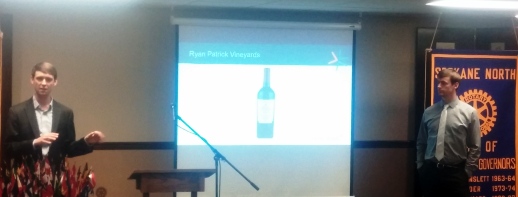What's in the Wine Label -- Wadkins and Johnson
Posted by Charles Rehberg
on Oct 19, 2015
Spokane North Notes
A weekly bulletin of the Spokane-North Rotary Club
October 19, 2015
Editors: Chuck Rehberg and Sandy Fink
Photos: Eric Johnson
Program Coordinator: Brad Stark
Help wanted: Bookie: No, not an odds-making bet–taker. President Lenore Romney said club directors would like to hire someone who can keep the books, help with bill paying and perhaps staff the front desk at meetings. That is a role Sandy Fink filled for a time, following Fred Bielen and others. Lenore said she has someone in mind for $17 an hour and asked if other members had other suggestions. “We can’t afford (accounting) firms,” Romney added.
Work-in-progress: Fund-raising coordinator Jodi Harland said she and Robbie Jackson “are tweaking” a letter to prospective donors, so firms can consider donating a larger gift to the club for projects at Holmes School and to help needy children in other ways. Jodi said the letter awaits a brief message from Holmes Principal Stephanie Lundberg and a thank-you note from a student.
Sign up for GU visit: Signature sheets were distributed for members to sign up for the Nov. 9 field trip to the new $60 million Hemmingson Student Union at Gonzaga. Coordinator Brad Stark said food providers need an accurate count of members and guests. Parking is available in the garage near the bookstore on the east side of the GU campus.
What is red and white and served all over?
The presentation was thorough and informative.
The guest speakers even handed out spiffy corkscrews bearing their law firm’s name.
But, alas, there was nary a drop of vino to sample as club members Oct. 19 experienced a class in “Wine Law 101.”
 Dan Wadkins and Reid Johnson of the noted Spokane firm Lee and Hayes provided enough information to work up a mighty thirst, but members had to suffice with water, lemonade, ice tea and coffee.
Dan Wadkins and Reid Johnson of the noted Spokane firm Lee and Hayes provided enough information to work up a mighty thirst, but members had to suffice with water, lemonade, ice tea and coffee.Spokane-based Lee and Hayes is one of the country’s top patent-law firms and has branches in Atlanta, Austin, Portland, Seattle, Washington, D.C., and Rochester, New York. And, if Johnson and Wadkins are any indication, the firm does pretty well in wine law, too.
Their talk focused on “what goes in to putting wine in a bottle and what goes on the label,” Johnson said.
“Trademarks are the most valuable asset of a winery,” Wadkins added.
Among the info-nuggets:
- Natural wine must have 7-24 percent alcohol content by volume.
- Wines with less than 7 percent alcohol content, including some dessert wines, are governed by the FDA and need nutrition facts on labels.
- Wine labels are regulated by the Alcohol and Tobacco Tax and Trade Bureau, which requires that every label includes the brand name, one of nine different class types, the alcohol content a surgeon general’s warning, sulfites and the name and address of the bottler or importer.
- Optional label information may include the varietals, the vintage, whether the wine was “estate bottled,” and geographic indicators.
- If the label states on “appellation of origin,” at least 75 percent of the grapes must come from that area. Washington, for example, has 13 American Viticultural Areas (AVAs).
(Getting thirsty yet?)
- Listings of varietals must state the exact percentage of each and vintage years are “a key distinction.”
- Labels which say “estate bottled” basically mean the vintner “has controlled all aspects of production, from growth of the grapes to the bottling.” By contrast, wines labeled “estate grown,” means the vintner controlled the planting and harvest, but vintage was bottled elsewhere.
- Not allowed on the labels are “false, untrue and misleading statements.”
- Even the artwork is scrutinized. Bottles of Cycles Gladiator wine featured a famous French painting with a side view of a nude nymph. Federal agents said the artwork was acceptable, but
Alabama regulators said the label was “indecent.”
Wadkins said Washington viticulture has grown from 19 wineries in 1981 to 850 wineries today, the second largest number in the U.S. Some 14.8 million acres are involved in grape-growing and the economic impact even five years ago was $8.6 billion. White wines are 53 percent of the total; reds, 47 percent, he said.
(Thirsty now?)
Washington, Wadkins said, “focuses on the premium wine segment, bottles sold for $8 or more.” Chateau St. Michele, he adds, “sells more Reisling than anyone in the world. St. Michele alone uses two or
every three grapes grown in Washington for its name brand, plus Columbia Crest and 14 Hands vintages. What many do not know, he said, is that the parent company is a Phillip Morris subsidiary.
Johnson said the recent, persistent drought has not hurt the industry. “Wine grapes are very efficient and do not need much water,” he said, adding, “for reds, you stress the grapes and hold back water anyway.”
Good viticulture areas don’t stop at the borders, Wadkins and Johnson said. The 11-million –acre Columbia Valley AVA crosses into Oregon and premiere wine growing area of northern Washington – the Okanogan Valley -- is also Canada’s premiere wine acreage.
(If you have read this far, you have earned a glass or two – Washington wine, of course.)'
